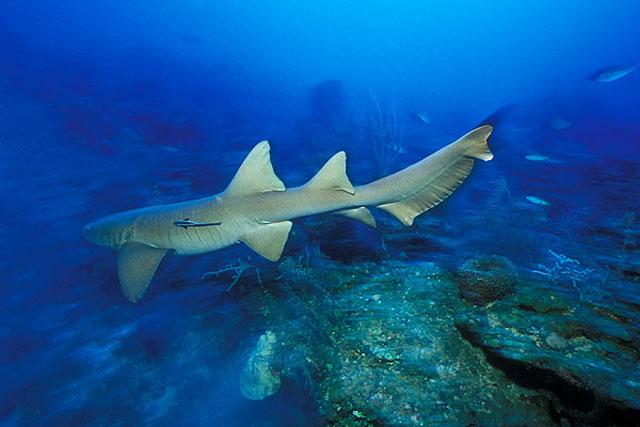| Ginglymostomatidae (Nurse sharks) |
| 430 cm TL (male/unsexed); max.weight: 110 kg; max. reported age: 25 years |
|
reef-associated; brackish; marine; depth range 0 - 130 m |
| Western Central Atlantic: Rhode Island to southern Brazil (south to Rio de Janeiro), including Gulf of Mexico and Caribbean coasts, although (exceptionally from Rhode Island to Texas), Bermuda; Eastern Central Atlantic: Cape Verde Islands, Senegal, Cameroon to Gabon, and rarely north to Bay of Biscaye, France (ref. 43278). Populations in eastern Pacific refer to Ginglymostoma unami Del Moral-Flores et al., 2015 (Ref. 113902). |
|
Dorsal spines (total): 0-0. Moderately long barbels, nasoral grooves present but no perinasal grooves, mouth well in front of eyes, spiracles minute, precaudal tail shorter than head and body, dorsal fins broadly rounded (the first much larger than the second and anal fins), caudal fin moderately long, over 1/4 of total length, yellow-brown to grey-brown in color, with or without small dark spots and obscure dorsal saddle markings (Ref. 247). Head blunt, mouth inferior, pair of conspicuous barbels between nostrils (Ref. 26938). |
| Found on continental and insular shelves. Solitary (Ref. 26340) and sluggish fish, often encountered lying on the bottom (Ref. 9987). Nocturnal, feeding on bottom invertebrates such as spiny lobsters, shrimps, crabs, sea urchins, squids, octopi, snails and bivalves, and fishes like catfishes, mullets, puffers and stingrays. Ovoviviparous with 21 to 28 young in a litter (Ref. 9987, 43278). Kept in captivity for researches. May attack humans if they are molested or stepped upon accidentally. Edible, but mainly valued for its hide, which makes extremely tough and durable leather (Ref. 9987). Common over shallow sand flats, in channels, and around coral reefs; young may be found among prop roots of red mangroves (Ref. 26938). |
|
Vulnerable (VU); Date assessed: 05 July 2019 (A2bcd) Ref. (130435)
|
| traumatogenic |
Source and more info: www.fishbase.org. For personal, classroom, and other internal use only. Not for publication.
